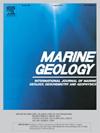一千年的岩化之旅:地中海中部藻礁的ct分析和放射性碳定年
IF 2.2
3区 地球科学
Q2 GEOSCIENCES, MULTIDISCIPLINARY
引用次数: 0
摘要
钙质藻礁是地中海的碳酸盐岩结构,由珊瑚红藻形成,显示了早期的岩化作用,并保存了重要的地球生物学记录。这些结构受到环境条件和生物相互作用的影响,呈现出复杂的三维框架,但它们的岩化过程、孔隙演化和长期生长模式仍然知之甚少。在这项研究中,我们使用计算机断层扫描(CT)和放射性碳定年技术对西西里岛东南部Marzamemi近海沿深度梯度收集的四个珊瑚堆积进行了研究,以调查内部骨骼密度、孔隙度分布和年龄分布。研究结果表明,岩石化过程由高密度(HD)向超高密度(UHD)逐渐发展,与孔隙度呈负相关。放射性碳定年法表明,石化时间大约为1000年,最古老、密度最大的物质可以追溯到5000多年前。这些结构表现出深度-密度和年龄-深度梯度:较深和较老的建筑物显示出较多的超高清物质,而较年轻、较浅的建筑物含有较高比例的超高清物质。此外,有证据表明,由于环境或人为因素,特定的堆积物可能已被分散和重新安置,从而进一步影响了增长模式。ct分析有助于提高对珊瑚礁形成和演化的认识,强调了岩化作用在维持数千年结构稳定性方面的作用,并提供了适用于化石礁系统研究的见解。本文章由计算机程序翻译,如有差异,请以英文原文为准。
A thousand-year journey of lithification: CT-analysis and radiocarbon dating of algal reef from Central Mediterranean
Calcareous algal reefs are Mediterranean carbonate structures, formed by coralline red algae, that display early lithification and preserve key geobiological records. These structures exhibit complex three-dimensional frameworks influenced by environmental conditions and biological interactions, but their lithification processes, porosity evolution, and long-term growth patterns remain poorly understood. In this study, we use Computed Tomography (CT) scanning and radiocarbon dating on four coralligenous build-ups collected along a depth gradient offshore Marzamemi, SE Sicily, to investigate internal skeletal density, porosity distribution, and age profiles. Our findings reveal that lithification progresses gradually from High-Density (HD) to Ultra-High-Density (UHD) material, correlating inversely with porosity. Radiocarbon dating indicates a lithification timeline of roughly 1000 years, with the oldest, densest material dating back over 5000 years. The structures demonstrate a depth-density and age-depth gradient: deeper and older build-ups exhibited higher quantity of UHD material, whereas younger, shallower build-ups contain a higher proportion of HD material. Additionally, evidence suggests that specific build-ups may have been fragmented and relocated due to environmental or anthropogenic factors, further influencing growth patterns. The CT-analysis contributes to improving knowledge on coralligenous reef formation and evolution, underscoring the role of lithification in maintaining structural stability over millennia and providing insights applicable to the study of fossil reef systems.
求助全文
通过发布文献求助,成功后即可免费获取论文全文。
去求助
来源期刊

Marine Geology
地学-地球科学综合
CiteScore
6.10
自引率
6.90%
发文量
175
审稿时长
21.9 weeks
期刊介绍:
Marine Geology is the premier international journal on marine geological processes in the broadest sense. We seek papers that are comprehensive, interdisciplinary and synthetic that will be lasting contributions to the field. Although most papers are based on regional studies, they must demonstrate new findings of international significance. We accept papers on subjects as diverse as seafloor hydrothermal systems, beach dynamics, early diagenesis, microbiological studies in sediments, palaeoclimate studies and geophysical studies of the seabed. We encourage papers that address emerging new fields, for example the influence of anthropogenic processes on coastal/marine geology and coastal/marine geoarchaeology. We insist that the papers are concerned with the marine realm and that they deal with geology: with rocks, sediments, and physical and chemical processes affecting them. Papers should address scientific hypotheses: highly descriptive data compilations or papers that deal only with marine management and risk assessment should be submitted to other journals. Papers on laboratory or modelling studies must demonstrate direct relevance to marine processes or deposits. The primary criteria for acceptance of papers is that the science is of high quality, novel, significant, and of broad international interest.
 求助内容:
求助内容: 应助结果提醒方式:
应助结果提醒方式:


